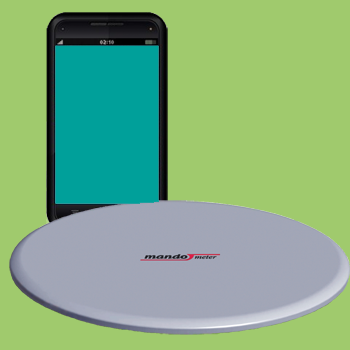In this page, you can access information as well as demonstration material concerning the technology that has been developed by and/or is being employed by SPLENDID

Mandometer®
The Mandometer® is a personal scale that connects to a smartphone. It describes in real-time the progression of a meal and it offers directions helping the user to control the size of their meals by normalising the way they are eating.
The Mandometer® has already been used in clinics around the world with great success, helping to treat patients with obesity or eating disorder. In the clinical setting the eating behaviour of the patients is recorded in test meals using the device. The Mandometer® is then used to guide patients to normalise their eating by offering real-time feedback for the patients to follow. Long term use of the Mandometer® has led to scientifically documented weight normalisation both of obese[1] and underweight patients[2].
In SPLENDID the Mandometer® will be used as the earliest identifier of the risk for developing obesity or eating disorders. It will also be an integral part of the platform that will be used to guide the person to a healthier eating behaviour.
Patent for the Mandometer® is held by Mando Group AB.
“From connected scales to sensors that can track heart rate and activity levels… the patient can be empowered to understand their healthcare data” – Daniel Kraft

Accelerometer
Accelerometers are used to track physical activity. As of late accelerometers have seen more and more use in the public health industry. Often they are paired with feedback systems keeping the users motivated[3,4].
In SPLENDID, accelerometers will be used to capture acceleration in all three axes of space, creating a 3D representation of how a person moves. Based on the accelerometer data, the overall physical activity of a person across a day will be calculated. It is also likely that some basic activity patterns such as lying, walking and running will be identified.
As part of the SPLENDID platform the accelerometer will be used to record the physical activity patterns of the users across a day. These recordings will be considered in the calculation of the risk for developing obesity or an eating disorder. During the lifestyle intervention phase, the accelerometer will be used as a tool to guide the person to healthier physical activity behaviour.
CSEM are tasked with development of the accelerometer.
Chewing sensor
The innovative chewing sensor developed especially for SPLENDID will collect information about the chewing patterns of the user across large parts of the day. While the design of the sensor is not yet finalized, it will be non-invasive and it will probably record sounds or other information from the jaw and throat area of the user in order to identify chewing.
In SPLENDID, the Chewing sensor will be used to collect additional information during meals. Through the quantification of chewing the system will also be able to automatically detect snacking across the day. This information will be considered in the algorithms used to calculate the risk for developing obesity or an eating disorder. During the lifestyle intervention phase, information collected with the Chewing sensor will be used to guide the person to a healthier eating behaviour.
CSEM is tasked with development of the chewing sensor.

Algorithms
SPLENDID will be a modular system with multiple sources of behavioural information, analysed in conjunction with the final goal to offer meaningful feedback helping users to normalise their behaviours. Specialised algorithms will be required in order to record, process, integrate and evaluate the collected information.
For example, algorithms that will be developed in SPLENDID will be used in:
- Raw signal processing
- Signal integration
- Risk calculation
Interfaces
SPLENDID is envisioned as a highly interactive system. For that, it will require specialised, user-friendly interfaces for the users to interact with the system.
For the students and the young adults to interact with the SPLENDID system, dedicated smartphone and web-based interfaces will be developed. In both platforms, the interfaces will emphasise on the presentation of behavioural recordings and feedback notifications, while allowing the user to manually add their input when required.
More elaborate interfaces will be designed for the health professionals that will be using the system. These interfaces will mostly be web-based and will handle the presentation of information, as well as receive feedback from the professional.
References


